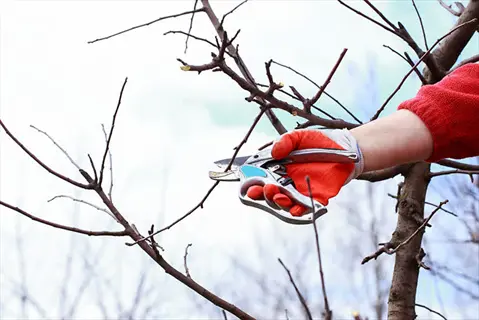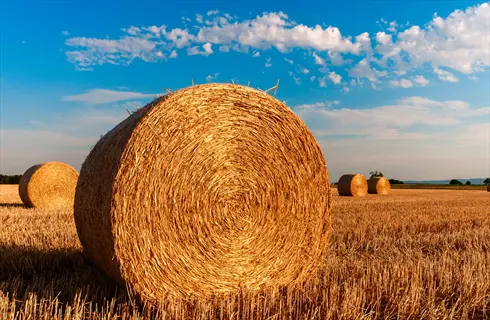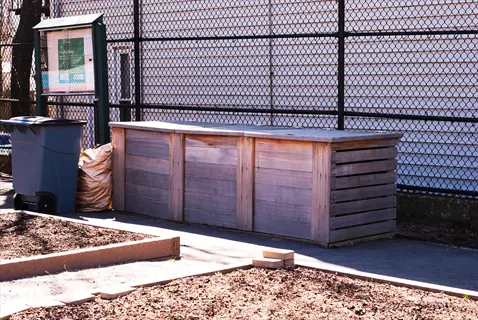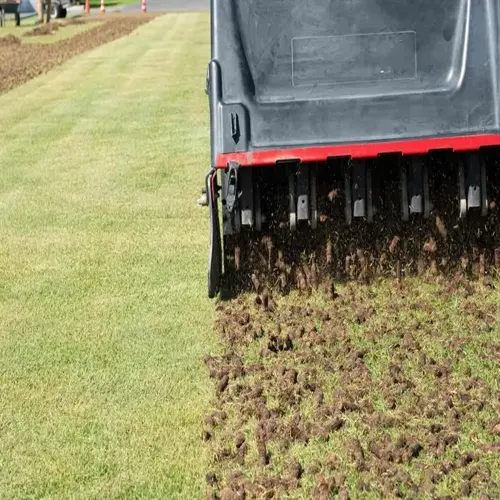Mulching Fruit Trees: Ultimate Guide

Written by
Benjamin Miller
Reviewed by
Prof. Samuel Fitzgerald, Ph.D.Covering fruit trees with mulch helps retain moisture while providing consistent soil temperature through the entire year.
Adjusting the depth of mulch seasonally protects plant roots from ice in winter and retains moisture in summer.
Natural materials like wood chips will decompose slowly to feed the soil environment over the long term.
Always ensure a six-inch gap between the wood chips and the trunk itself to limit the risk of disease and rodents.
If you are able to, you should source your wood chips from a local arborist for an affordable, sustainable wood source to protect your orchard from harsh temperatures.
When done properly, you can expect an increase in fruit production (up to 30%!) due to healthier roots.
Article Navigation
Mulching fruit trees means putting protective material around the soil of your orchard trees. This practice typically utilizes natural or man-made materials to protect the tree roots from extreme weather conditions. This practice works especially well with your apple, peach, and pear trees. Mulching provides proper soil coverage and retains moisture, while preventing soil erosion and weed invasion.
Proper application of mulch cultivates drought resilience even in the dry season, and the potential for double harvests can be achieved through optimum root health. The consistent retention of moisture and gradual release of nutrients create these conditions. Mulching is essential for sustainable orchard management for these reasons.
This guide explains important aspects, such as selecting the best types of mulch. It describes the best way to apply them for the age of the tree. You will learn seasonal techniques to lessen the effects of heat in summer and frost in the winter. By mastering these elements, your fruit trees will grow well from one year to the next.
Seasonal Mulching Strategies
Remember, in spring, the function of mulching is to release and give nutrients to the new growth. A less thick application of compost or manure is made at this time. In winter, the function of mulching is insulation and it should be laid on a thicker layer of wood chip bedding, etc., to protect the root system from frozen ground. Each thickness will be adjusted according to the season's priority, ensuring the best conditions for the trees.
The climate of your region dictates your plan of attack when it comes to mulch. Dry climates should have heavier summer layers to hold moisture, and I recommend something like four to six inches during heat waves. Humid regions should have lighter applications to avoid rot or decay of the mulch. Always watch the climatic tendencies of the locality to determine your own procedure.
Autumn applications prep trees for frost threats. Apply fresh mulch before the first freeze. This becomes a root-protecting barrier. This stabilizes soil temperatures throughout cold months. Your orchard gets vital defense against winter damage through timely autumn prep.
Unlike those planted in soil, a container tree needs constant attention. attention The few feet of soil dry out more rapidly than when grown in soil and require vigilance during the year. Once a week, moisture levels should be checked, and the mulch refreshed once a month. Root confinement is avoided by maintaining the proper depth. Such vigilance will keep potted fruit trees productive.
Drought Conditions
- Moisture Priority: Double compost layer under wood chips for water conservation
- Application: Water soil thoroughly before mulching to maximize retention
- Materials: Coconut coir holds 50% more water than conventional straw
Heavy Rainfall Areas
- Drainage Focus: Use coarse wood chips only to prevent waterlogging
- Timing: Apply after last spring downpour to conserve summer moisture
- Avoid: Straw retains excess moisture causing root rot in wet climates
Coastal Areas
- Salt Protection: Apply seaweed mulch to buffer salt spray damage
- Wind Resistance: Use heavier wood chips to prevent wind displacement
- Depth: Maintain 4-6 inches (10-15 cm) year-round for erosion control
Mountain Regions
- Frost Protection: Double winter mulch depth to 10 inches (25 cm)
- Materials: Pine needles provide natural insulation against freeze-thaw cycles
- Timing: Apply autumn mulch 4 weeks before first frost for root hardening
Urban Heat Islands
- Cooling Strategy: Use light-colored gravel over compost to reflect heat
- Water Conservation: Apply hydrogel crystals under wood chip mulch
- Depth Reduction: Limit to 2-3 inches (5-7.5 cm) to prevent overheating
Sustainable Mulch Sourcing
Utilize local mulch sources to reduce transportation emissions. Contact local arborists to obtain tree trimming instead of purchasing bagged products. In many communities, municipal yard-waste programs provide free materials in your own town. This expedites the use of fossil fuels and bolsters local sustainable living practices.
Look for certified sustainable wood products with either the FSC label or the SFI label. These labels ensure that trees come from sustainable sources. They prevent habitat destruction and ensure that the resource will always be available on an economically feasible basis. Your orchard benefits from the use of materials that are sustainably harvested and are in accordance with eco-conscious values and practices.
Consider environmental consequences carefully. Foraged materials such as fallen leaves deliver nearly zero carbon footprint. Purchasing bagged mulch creates emissions from processing and shipping. I have found that local sources cut transportation pollution by more than eighty percent compared to commercial products.
Participate in community-sharing initiatives, such as seasonal chip swaps, or organize mulch exchanges through local gardening organizations. These networks are adept at redistributing organic waste. You will receive a variety of materials while gaining experience in collective sustainable practices. Waste is transformed into the necessary resources for orchards.

Tree Service Chips
- Availability: Contact local arborists for free delivery of untreated hardwood chips
- Quality Tip: Specify chemical-free material suitable for edible gardens
- Storage: Create 3-foot (1m) piles covered with tarps for 6-month (183-day) curing

Autumn Leaves
- Collection: Gather neighborhood leaves using lawnmower bagging systems
- Processing: Shred leaves then compost in wire bins for 12-18 months (365-548 days)
- Output: Produces fungal-rich leaf mold per cubic yard (0.76 m³) of leaves

Pruning Waste
- Ramial Technique: Chip disease-free branches under 2 inches (5 cm) diameter
- Nutrient Value: Young wood contains 2x more nitrogen than mature trunks
- Application: Spread 1-inch (2.5 cm) layers around tree drip lines

Agricultural Byproducts
- Sources: Local grain farms often discard imperfect straw/hay bales
- Weed Prevention: Ensure heat-treated bales to kill weed seeds
- Layering: Combine with compost to prevent nitrogen depletion in soil

Community Resources
- Programs: Municipal yard waste recycling centers offer free compost
- Sharing: Neighborhood apps facilitate organic material exchanges and chip swaps
- Events: Organize seasonal 'mulch swap' days for bulk material trading
Types of Fruit Tree Mulch
Compare the moisture retention abilities of organic mulches before choosing. Wood chips are good for moisture retention, while straw has moderate retention. Leaf mold is most effective in moist areas due to its superior drainage. Coconut coir has poor moisture retention, but it requires constant watering, especially in dry soil.
Willow mulch naturally prevents disease due to its salicylic acid content. This improves tree resistance to common fungal diseases. It should be applied in thin layers in the root zone of apple and stone fruit trees. This provides effective protection against disease-prone orchards in humid conditions.
Choose materials based on local adaptations. Use straw in dry Mediterranean climates to control evaporation. Use leaf mold in humid coastal climates needing better drainage. Select mulch attributes to match local conditions to enhance the performance and health of fruit trees.
Maintain a nitrogen balance when applying wood-based mulches. Fresh wood chips tie up surface nutrients temporarily during decomposition. This prevents deficiency if a compost or aged manure foundation is used. This allows for constantly available nutrition while decomposition occurs, which is favorable to the feed roots.
Wood Chips
- Nitrogen Management: Layer over compost to prevent depletion; add aged manure annually
- Regional Tip: Use hardwood chips in humid climates to resist fungal breakdown
- Avoid: Dyed or treated wood products near edible fruit trees
- Dry Climates: Maintain 4-inch depth for maximum water retention
Compost
- Timing: Apply in spring before growth season for maximum nutrient uptake
- Composition: Mix fruit/vegetable scraps with yard waste for balanced NPK
- Caution: Ensure proper curing (6 months minimum) to avoid root burn
- Humid Regions: Combine with wood chips to prevent nutrient leaching in heavy rains
Straw
- Weed Control: Must be seed-free and applied 6 inches (15 cm) deep
- Pest Management: Avoid in vole-prone areas; use sharp gravel barrier
- Water Efficiency: Reduces evaporation by 30% in arid climates
- Regional Fit: Ideal for Mediterranean and desert climates with low rainfall
Leaf Mold
- Production: Shred oak/maple leaves and compost for 12-18 months
- Soil Benefits: Increases water retention by 25% in sandy soils
- Application: Mix with wood chips for fungal-dominated soil ecosystems
- Humid Areas: Preferred in rainy regions for superior drainage properties
Ramial Wood
- Source: Use branches under 2 inches (5 cm) from disease-free pruning
- Nutrient Release: Provides slow-release calcium/magnesium over 2 years (730 days)
- Preparation: Chip fresh wood and age 3 months before application
- Cold Climates: Provides insulation against freeze-thaw cycles in northern zones
Willow Mulch
- Disease Prevention: Contains salicylic acid to boost tree immunity against fungi
- Harvesting: Cut young willow branches in early spring for peak potency
- Usage: Layer thin amounts over compost near root zones annually
- Wet Regions: Especially effective in high-humidity disease-prone areas
How to Apply Mulch Correctly
Always leave a 6-inch gap at the trunk when applying mulch. This important space is to keep moisture from accumulating against the bark. Excess moisture encourages the growth of rot diseases and insect infestations. Form a clear donut shape around the base of each tree. The simple barrier helps keep your fruit trees healthy and vigorous.
Adjust the depth requirements of the mulch to the degree of the tree's growth. Young trees benefit from a mulch depth of only 2 inches. Mature trees require a mulch depth of 4 inches for adequate insulation. Measure the mulch carefully so that tree roots are not smothered in place, a distinction that is beneficial for the tree's growth at all stages of its life.
For your type of soil prepare the moisture in the soil. Sandy soils require a deep soaking before mulching. Clay soils require moderate moisture to prevent waterlogging. Check for the moisture 6 inches deep with the soil auger. This will prevent hydrophobic conditions from developing under the mulch layer.
Time applications according to seasonal climatic variations. Temperate zone applications are made early in the spring after the frost. Mediterranean climates use applications just before the autumn rains. Tropical places use applications in the dry season. Use a schedule according to your local climatic conditions for maximum effectiveness in the orchard.
Mulch Touching Trunk
- Problem: Causes bark rot and pest infestation
- Fix: Maintain 6 inches (15 cm) gap; redistribute excess material
- Prevention: Use donut-shaped application method
Insufficient Depth
- Problem: Weeds penetrate thin layers; poor moisture retention
- Fix: Add 1-2 inches (2.5-5 cm) extra material
- Guideline: Minimum 3 inches (7.5 cm) for weed suppression
Over-Mulching
- Problem: Roots suffocate when depth exceeds 6 inches (15 cm)
- Fix: Remove excess down to 4 inches (10 cm) maximum
- Warning: Causes root rot in heavy clay soils
Poor Water Penetration
- Problem: Water runs off compacted mulch
- Fix: Fluff and turn existing mulch with garden fork
- Maintenance: Break up crusted layers seasonally
Material Washaway
- Problem: Heavy rain displaces lightweight mulches
- Fix: Install edging; use heavier wood chips on slopes
- Alternative: Coconut coir mats anchor straw in storms
Nitrogen Deficiency
- Problem: Fresh wood chips deplete soil nitrogen
- Fix: Add nitrogen-rich blood meal or aged manure
- Prevention: Always layer wood chips over compost
Young vs Mature Trees
- Young Trees: Maintain smaller 3 ft (0.9 m) mulch circle for first 3 years
- Mature Trees: Extend mulch to drip line (branch canopy edge)
- Depth Difference: Young trees need 2 inches (5 cm), mature trees 4 inches (10 cm)
Seasonal Timing
- Temperate Climates: Apply in early spring (March-April) and late autumn (October-November)
- Mediterranean Climates: Best in autumn before rains; refresh in early summer
- Tropical Zones: Apply at start of dry season (November-December)
Common Mulch Mistakes to Avoid
Mulch in contact with tree trunks promotes bark rot diseases such as phytophthora. This fungal disease enters through moist bark. Insect borers may also attack weakened trees. Maintain a 6-inch clear zone circumscarpting the trunks. Your prevention avoids these destructive problems before they start.
Volcano mulching creates an excessive pile of material adjacent to the stems. This trapping of moisture suffocates the roots by blocking the oxygen supply. A proper flat application maintains a uniform depth over all root zones. Spread your mulch evenly, like a pancake, and not in a mountainous pile. You give your trees protection without suffocating them.
New wood chips cause nitrogen depletion as they bind nutrients during degradation. This nutrient binding leads to the yellowing of leaves found on young trees. You can minimize homeostasis with the combination of cigarettes mulched onto a composted type of organic matter. You create a layer preventing nitrogen deficiency while using valuable organic matter.
Colored mulches contain toxic chemicals, such as arsenic, which will leach into the soil after rain. Heavy metals accumulate within the root system of trees, especially those of fruit trees. Always choose natural and undyed materials. Your orchard will be productive without the risk of chemical contamination.
Volcano Mulching
- Root Suffocation: Oxygen levels drop below 5 percent at 8 inches (20 cm) depth
- Disease Spread: Trapped moisture increases fungal infection risk threefold
- Rodent Damage: Creates nesting habitat for bark-gnawing voles
Trunk Contact
- Bark Rot: Continuous moisture causes phytophthora infection (common in apples and stone fruits)
- Insect Infestation: Borers establish in softened bark tissue
- Girdling Roots: Promotes abnormal root growth that strangles trunk
Fresh Wood Chips
- Nitrogen Theft: Depletes 0.5 pounds (227 grams) nitrogen per cubic yard (0.76 m³)
- Growth Stunting: Young trees show 40 percent less shoot growth in first year
- Leaf Yellowing: Magnesium deficiency appears within 3 months
Dyed Mulch
- Chemical Leaching: Arsenic and creosote contaminants detected in soil after rain
- Root Toxicity: Heavy metals accumulate in fruit tree roots
- Ecosystem Harm: Kills beneficial earthworms and mycorrhizal fungi
Thin Application
- Weed Breakthrough: 80 percent weed resurgence below 3 inches (7.5 cm) depth
- Moisture Loss: Evaporation increases seventy percent in first week
- Root Exposure: Temperature fluctuations stress feeder roots
Dry Soil Base
- Hydrophobic Layer: Creates water-repellent barrier in sandy soils
- Root Desiccation: Soil moisture drops fifty percent below mulch layer
- Nutrient Lockup: Prevents fertilizer absorption into dry root zone
5 Common Myths
It is inevitable that wood chips rob necessary nitrogen from the roots of fruit trees when they are used as a mulch material.
While new wood chips take up nitrogen in the surface layers during the process of decay, this can only affect the upper 2 inches (5 cm) of soil, where the feeders are located. The fruit trees have their nitrogen below this, where the nitrogen is not affected by the surface conditions. The way to take care of this is to put wood chips over compost or well-aged manure, where there will be sufficient balance of nutrition all through the decaying period to secure against lack of nutrition.
Pine mulch constantly gives acidity conditions to the soil and is detrimental to fruit trees preferring neutral pH conditions.
The decomposition of pine needles results in a near-neutral pH due to the action of the microbial buffers present. The tolerable pH for fruit trees varies from 5.5 to 7.5, hence if properly applied the pine mulch will not render the tree sick from its acidity. Do not allow it to touch the trunk of the trees and maintain the correct depth for maximum tree health in all growing conditions.
All kinds of mulch will attract insect pests and rodents to trees in fruit orchards and there cannot be any exception to this rule.
Where mulch is properly applied and the space maintained around the trunk weeds are discouraged and the conditions for insect life made distinctly unfavorable. Beneficial predatory tribes being strangely influenced by coarse material such as wood chips, form a natural obstacle when used properly. Correct depth when regular inspections for necessary thinning are made will retain a check on insect life while gaining harmonious coexistence with healthy tree conditions in the soil.
The application of mulch completely eliminates any need for additional fertilization of fruit trees whatsoever.
Organic mulches supplement but do not take the place of full nutrition programs which are required to produce the most fruit. While decomposing materials give nutrients slowly, fruit trees require specific NPK ratios during critical growth periods. Regular analysis of soil is of prime importance in order to ascertain any deficiencies which need supplemental fertilizing along with the practice of mulching. This is essential in providing for the elements of food that have been found to be best in producing fruit.
Piles of mulch shaped like volcanoes protect tree trunks and greatly improve growth and health.
Mulching against tree trunks retains moisture, causing bark to rot, disease to enter, and depletion of oxygen to the roots. Trees receiving volcano mulching experience much greater rates of borer action and root rrot. After all, the correctly flat application prevents damaging the trunks but more maintains a proper teperature and moisture in the soil so that both the health of the trunk and the function of the work are not impaired.
Conclusion
Mulching fruit trees provides key benefits including the conservation of moisture and the suppression of weeds. This process regulates soil temperature while adding organic nutrients. Your orchard receives a natural buffer against environmental stresses. These benefits lead directly to healthier trees and increased fruit yields, with no additional labor required.
Concentrate on the practical part rather than theorising. Measure the gaps between the trunks before applying the materials. Adjust depths depending on the season and tree maturity. Create reminders for when to refresh for autumn. Your practical approach enables the techniques to be proven effective in real-life orchard conditions.
Seasonal strategies directly influence the longevity of trees. Spring applications help with growing seasons, and winter applications protect against root loss. Seasonal, consistent care builds resilience over the years, allowing trees to develop stronger root systems and continue to produce fruit for years to come through regular applications.
Take immediate action now with these easy steps. Clear all mulch from your tree trunks today. Pick up some local wood chips this weekend. Mark your calendar for dates to refresh this autumn. Start small with one tree before expanding your mulching.
External Sources
Frequently Asked Questions
What is the best type of mulch for fruit trees?
Wood chips are ideal for moisture retention, while compost boosts nutrients. Straw works well for weed suppression in dry climates, and leaf mold improves fungal soil health. Avoid dyed or chemically treated products near edible trees.
Should you mulch around fruit trees?
Yes, mulching regulates soil temperature, conserves water, and suppresses weeds. It also prevents soil compaction and adds organic nutrients as it decomposes. Always maintain proper depth and avoid trunk contact for optimal tree health.
How do you prevent weeds around fruit trees?
Apply coarse organic mulch at sufficient depth to block sunlight. Effective methods include:
- Wood chips or straw layers at least 3 inches deep
- Regularly refreshing mulch to maintain coverage
- Creating physical barriers with edging
- Hand-pulling weeds before seeding
What common mistakes should you avoid when mulching?
Critical errors include piling mulch against trunks, using fresh uncomposted wood chips, applying dyed products, insufficient depth, and mulching dry soil. These cause root rot, nitrogen depletion, and chemical contamination that harm trees.
Can kitchen waste be used as tree mulch?
Composted vegetable scraps work well, but avoid meat or dairy. Rhubarb leaves are acceptable only when fully decomposed. Fresh materials must be processed for several months to prevent pest attraction and nutrient imbalances.
How often should mulch be replaced?
Refresh annually in spring, adding material to maintain depth. Complete replacement isn't necessary as organic mulch decomposes naturally. In rainy seasons, check for compaction and fluff existing layers to maintain effectiveness.
Is mulch safe for all fruit trees?
Most benefit, but avoid certain materials for specific trees:
- Citrus: Skip acidic pine needles
- Young saplings: Use thinner layers
- Wet-climate trees: Avoid moisture-retaining straw
- All varieties: Maintain trunk clearance
How does mulch depth change with seasons?
Apply thinner layers in spring for nutrient release, thicker in winter for insulation. Increase depth for cold regions before frost, and reduce slightly during rainy periods to prevent waterlogging and disease development.
Can you use grass clippings as mulch?
Yes, but only when dried and mixed with carbon-rich materials like leaves. Fresh clippings mat together, causing odor and nitrogen imbalances. Apply in thin layers and avoid clippings from chemically treated lawns.
Why maintain space between mulch and tree trunks?
Direct contact causes bark rot, invites pests, and promotes girdling roots. A minimum clearance prevents moisture buildup where diseases thrive. This critical practice significantly extends tree lifespan and fruit production.

